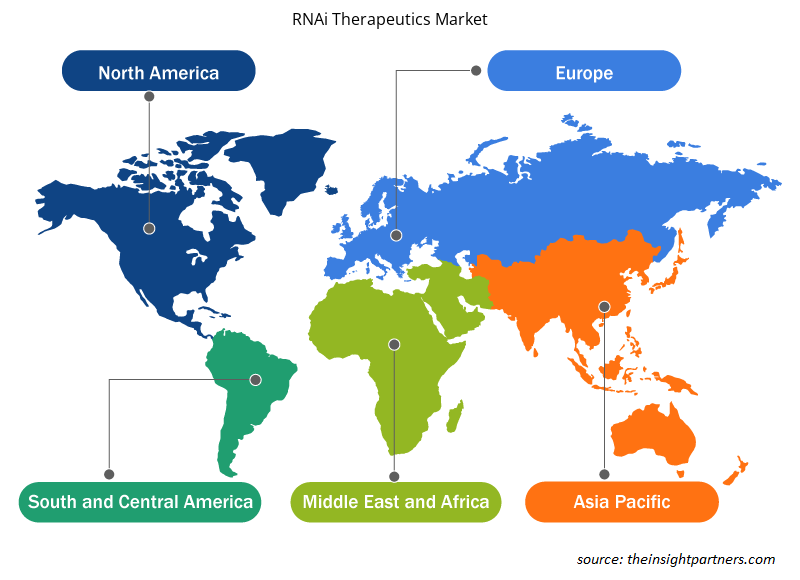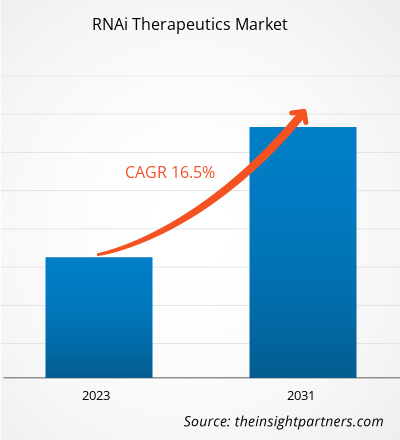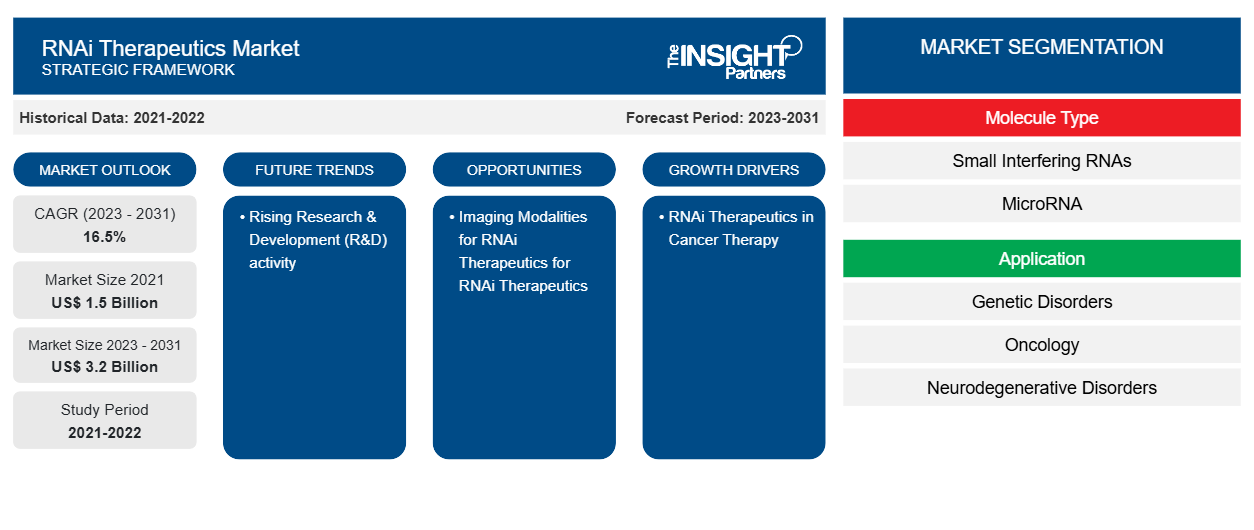Der Markt für RNAi-Therapeutika wurde 2021 auf 1,5 Milliarden US-Dollar geschätzt und soll bis 2031 3,2 Milliarden US-Dollar erreichen. Von 2023 bis 2031 wird für den Markt eine durchschnittliche jährliche Wachstumsrate von 16,5 % erwartet. Steigende Forschungs- und Entwicklungsaktivitäten (F&E) werden voraussichtlich weiterhin wichtige Trends auf dem Markt für RNAi-Therapeutika bleiben.
RNAi-TherapeutikaMarktanalyse
RNAi-Therapeutika in der Krebstherapie
Die RNAi-Technik ist eine neue Methode zur Krebstherapie, für die mehrere Kandidaten klinisch getestet werden. Der wesentliche Vorteil von RNAi für die Krebstherapie ist ihre hohe Spezifität mit einer unendlichen Auswahl an Genen, die in der Krebstherapie eingesetzt werden können. Beispielsweise könnten RNAi-Therapeutika die Angiogenese, Metastasierung, Chemoresistenz von Tumoren und die Proliferation von Krebszellen beeinträchtigen . Darüber hinaus befinden sich 10 Arten von RNAi-basierten Krebstherapeutika in der frühen Phase klinischer Studien, was die potenzielle Fähigkeit von RNAi mit spezifischer Gen-Silencing-Wirksamkeit zur Krebsbehandlung demonstriert. Daher sind die oben genannten Faktoren für das einflussreiche Wachstum des Marktes für RNAi-Therapeutika in den Jahren 2021–2031 verantwortlich.
RNAi-TherapeutikaMarktübersicht
Technologie, Innovation und intelligente technologische Lösungen wie diese beeinflussen die RNAi-Therapeutik weiterhin erheblich. RNAi-Therapeutik in der Krebstherapie und zunehmende klinische Studien zur Entwicklung innovativer RNAi-Therapeutika sind die einflussreichsten Faktoren, die für das Wachstum des Marktes für RNAi-Therapeutika verantwortlich sind. Steigende Forschungs- und Entwicklungsaktivitäten (F&E) sind ein wichtiger Trend für das Wachstum des Marktes für RNAi-Therapeutika. Bildgebungsverfahren für RNAi-Therapeutika bieten lukrative Marktchancen.
Passen Sie diesen Bericht Ihren Anforderungen an
Sie erhalten kostenlos individuelle Anpassungen an jedem Bericht, einschließlich Teilen dieses Berichts oder einer Analyse auf Länderebene, eines Excel-Datenpakets sowie tolle Angebote und Rabatte für Start-ups und Universitäten.
-
Holen Sie sich die wichtigsten Markttrends aus diesem Bericht.Dieses KOSTENLOSE Beispiel umfasst eine Datenanalyse von Markttrends bis hin zu Schätzungen und Prognosen.
RNAi-TherapeutikaMarkttreiber und Chancen
Zunehmende klinische Studien zur Entwicklung innovativer RNAi-Therapeutika begünstigen den Markt
- Im August 2023 kündigte Sirnaomics die klinische Phase 1 des RNAi-Therapeutikums „STP707“ an, das vielversprechendes klinisches Potenzial für metastasierte Tumore zeigte. Die klinische Studie wurde in den USA unter Beteiligung mehrerer führender Krebszentren durchgeführt, darunter Mayo Clinic Oncology, Emory Cancer Center, University of Southern California/Hoag und Yale Cancer Center.
- Darüber hinaus verfügt das Unternehmen Alnylam über eine robuste Pipeline experimenteller RNAi-Therapeutika, um den Bedarf von Patienten zu decken, die nur begrenzte oder unzureichende Behandlungsmöglichkeiten für Krankheiten haben, darunter: genetische Medikamente, kardiometabolische Erkrankungen , Infektionskrankheiten sowie Erkrankungen des zentralen Nervensystems (ZNS) und der Augen. Zu den Produkten gehören „ONPATTRO“, „AMVUTTRA“, „GLVLAARI“, „OXLUMO“, „Leqvio“, „Vutrisiran“, „Fitusiran“, „Cemdisiran“, „Zilebrsiran“, „ALN-HSD“, „Elebsiran“, „Belcesiran“, „ALN-APP“, „ALN-TTRsc04“, „ALN-APP“, „ALN-KHK“, „ALN-BCAT“, „ALN-PNP“.
Daher werden in den kommenden Jahren zunehmend mehr klinische Studien für RNAi-Therapeutika einen erheblichen Beitrag leisten.
Bildgebungsmodalitäten für RNAi-Therapeutika für den RNAi-Therapeutika-Markt – eine Chance
Derzeit werden in der RNAi-bezogenen Forschung mehrere molekulare Bildgebungsverfahren angewendet, wie etwa optische Bildgebung (Fluoreszenz und Biolumineszenz), Magnetresonanztomographie (MRT), Magnetresonanzspektroskopie (MRS), SPECT und Positronen-Emissions-Tomographie (PET). Auch die molekulare Bildgebung der therapeutischen Wirkungen von RNAi befindet sich noch im präklinischen Stadium und konzentriert sich auf die Visualisierung der Expressionsniveaus von Markergenen bei lebenden Tieren. Diese Bildgebungsmarker sind meist biolumineszierende Enzyme, deren pharmakologische Aktivität genau gemessen werden kann. Darüber hinaus erweist sich MRS auch bei der Bewertung der Wirksamkeit von RNAi-basierten Therapien als nützlich, da es das Potenzial hat, biologische Ergebnisse direkt zu erkennen. Darüber hinaus funktioniert MRS besser als optische Bildgebung bei der Messung der chemischen Verschiebungen bestimmter Verbindungen (z. B. Cholin), deren Konzentration in Geweben oder Tumoren durch bestimmte therapeutische Eingriffe verändert werden kann. Daher bieten F&E-Aktivitäten lukrative Marktchancen, die in den kommenden Jahren einen erheblichen Marktanteil für den Markt für RNAi-Therapeutika ausmachen werden.
RNAi-Therapeutika
Marktbericht-Segmentierungsanalyse
Wichtige Segmente, die zur Ableitung der Marktanalyse für RNAi-Therapeutika beigetragen haben, sind Kandidaten und Dienstleistungen.
- Basierend auf dem Molekültyp ist der Markt für RNAi-Therapeutika in Small Interfering RNAs (siRNA) und MicroRNA (miRNA) unterteilt. Die Small Interfering RNAs (siRNA) könnten im Jahr 2023 einen größeren Marktanteil haben.
- Basierend auf der Anwendung ist der Markt für RNAi-Therapeutika in genetische Störungen, Onkologie, neurodegenerative Störungen, Herz-Kreislauf-Erkrankungen, Atemwegserkrankungen, Infektionskrankheiten, Nierenerkrankungen und andere unterteilt. Die Onkologie könnte im Jahr 2023 einen größeren Marktanteil halten.
- Basierend auf der Verabreichungsmethode ist der Markt für RNAi-Therapeutika in intradermale Injektionen, pulmonale Verabreichung, intravenöse Injektionen, intraperitoneale Injektionen und andere unterteilt. Die pulmonale Verabreichung könnte im Jahr 2023 einen größeren Marktanteil haben.
- Basierend auf dem Endnutzer ist der Markt für RNAi-Therapeutika in Diagnoselabore, Forschungs- und akademische Labore sowie Krankenhäuser unterteilt. Die Forschungs- und akademischen Labore könnten im Jahr 2023 einen größeren Marktanteil halten.
RNAi-Therapeutika Marktanteilsanalyse nach geografischer Lage
Der geografische Umfang des Berichts zum Markt für RNAi-Therapeutika ist hauptsächlich in fünf Regionen unterteilt: Nordamerika, Asien-Pazifik, Europa, Naher Osten und Afrika sowie Südamerika/Süd- und Mittelamerika.
Nordamerika dominiert den Markt für RNAi-Therapeutika. In Nordamerika haben die USA einen beträchtlichen Anteil an RNAi-Therapeutika. In den USA sind führende Akteure der medizinischen Biotechnologie und Pharmaindustrie vertreten. Darüber hinaus ist die Präsenz von Auftragsforschungsinstituten (CROs), die die Forschungs- und Entwicklungsaktivitäten (F&E) verstärken, einer der einflussreichsten Faktoren für das Marktwachstum. Der asiatisch-pazifische Raum wird in den kommenden Jahren voraussichtlich die höchste durchschnittliche jährliche Wachstumsrate aufweisen.
RNAi-Therapeutika
Regionale Einblicke in den Markt für RNAi-Therapeutika
Die regionalen Trends und Faktoren, die den Markt für RNAi-Therapeutika im Prognosezeitraum beeinflussen, wurden von den Analysten von Insight Partners ausführlich erläutert. In diesem Abschnitt werden auch die Marktsegmente und die Geografie von RNAi-Therapeutika in Nordamerika, Europa, im asiatisch-pazifischen Raum, im Nahen Osten und Afrika sowie in Süd- und Mittelamerika erörtert.

- Erhalten Sie regionale Daten zum Markt für RNAi-Therapeutika
Umfang des Marktberichts zu RNAi-Therapeutika
| Berichtsattribut | Details |
|---|---|
| Marktgröße im Jahr 2021 | 1,5 Milliarden US-Dollar |
| Marktgröße bis 2031 | 3,2 Milliarden US-Dollar |
| Globale CAGR (2023 - 2031) | 16,5 % |
| Historische Daten | 2021-2022 |
| Prognosezeitraum | 2023–2031 |
| Abgedeckte Segmente |
Nach Molekültyp
|
| Abgedeckte Regionen und Länder |
Nordamerika
|
| Marktführer und wichtige Unternehmensprofile |
|
Marktteilnehmerdichte für RNAi-Therapeutika: Auswirkungen auf die Geschäftsdynamik verstehen
Der Markt für RNAi-Therapeutika wächst rasant, angetrieben durch die steigende Nachfrage der Endnutzer aufgrund von Faktoren wie sich entwickelnden Verbraucherpräferenzen, technologischen Fortschritten und einem größeren Bewusstsein für die Vorteile des Produkts. Mit steigender Nachfrage erweitern Unternehmen ihr Angebot, entwickeln Innovationen, um die Bedürfnisse der Verbraucher zu erfüllen, und nutzen neue Trends, was das Marktwachstum weiter ankurbelt.
Die Marktteilnehmerdichte bezieht sich auf die Verteilung der Firmen oder Unternehmen, die in einem bestimmten Markt oder einer bestimmten Branche tätig sind. Sie gibt an, wie viele Wettbewerber (Marktteilnehmer) in einem bestimmten Marktraum im Verhältnis zu seiner Größe oder seinem gesamten Marktwert präsent sind.
Die wichtigsten auf dem Markt für RNAi-Therapeutika tätigen Unternehmen sind:
- Alnylam Pharmaceuticals, Inc.,
- Sanofi,
- Olix Pharmaceuticals, Inc.,
- GlaxoSmithKline Plc,
- Benitec Biopharma,
- Arbutus Biopharma Corporation,
Haftungsausschluss : Die oben aufgeführten Unternehmen sind nicht in einer bestimmten Reihenfolge aufgeführt.

- Überblick über die wichtigsten Akteure auf dem RNAi-Therapeutika-Markt
RNAi-TherapeutikaMarktnachrichten und aktuelle Entwicklungen
Der Markt für RNAi-Therapeutika wird durch die Erhebung qualitativer und quantitativer Daten aus Primär- und Sekundärforschung bewertet, die wichtige Unternehmensveröffentlichungen, Verbandsdaten und Datenbanken umfasst. Im Folgenden finden Sie eine Liste der Entwicklungen auf dem Markt für RNAi-Therapeutika und Strategien:
- Im April 2024 kündigte Novartis die Markteinführung von „Leqvio“ an, einer maximal verträglichen Statintherapie vor der in den Leitlinien empfohlenen Ezetimib in einer realen Umgebung, wodurch das Low-Density-Lipoprotein-Cholesterin (LDL-C) bei Patienten mit atherosklerotischen Herz-Kreislauf-Erkrankungen (ASCVD) gesenkt wird.
Marktbericht zu RNAi-Therapeutika – Abdeckung und Ergebnisse
Der Bericht „Marktgröße und Prognose für RNAi-Therapeutika (2021–2031)“ bietet eine detaillierte Analyse des Marktes, die die folgenden Bereiche abdeckt:
- Marktgröße und Prognose auf globaler, regionaler und Länderebene für alle wichtigen Marktsegmente, die im Rahmen des Projekts abgedeckt sind
- Marktdynamik wie Treiber, Beschränkungen und wichtige Chancen
- Wichtige Zukunftstrends
- Detaillierte PEST/Porters Five Forces- und SWOT-Analyse
- Globale und regionale Marktanalyse mit wichtigen Markttrends, wichtigen Akteuren, Vorschriften und aktuellen Marktentwicklungen
- Branchenlandschaft und Wettbewerbsanalyse, einschließlich Marktkonzentration, Heatmap-Analyse, prominenten Akteuren und aktuellen Entwicklungen
- Detaillierte Firmenprofile
- Historische Analyse (2 Jahre), Basisjahr, Prognose (7 Jahre) mit CAGR
- PEST- und SWOT-Analyse
- Marktgröße Wert/Volumen – Global, Regional, Land
- Branchen- und Wettbewerbslandschaft
- Excel-Datensatz
Aktuelle Berichte
Verwandte Berichte
Erfahrungsberichte
Grund zum Kauf
- Fundierte Entscheidungsfindung
- Marktdynamik verstehen
- Wettbewerbsanalyse
- Kundeneinblicke
- Marktprognosen
- Risikominimierung
- Strategische Planung
- Investitionsbegründung
- Identifizierung neuer Märkte
- Verbesserung von Marketingstrategien
- Steigerung der Betriebseffizienz
- Anpassung an regulatorische Trends























 Kostenlose Probe anfordern für - Markt für RNAi-Therapeutika
Kostenlose Probe anfordern für - Markt für RNAi-Therapeutika